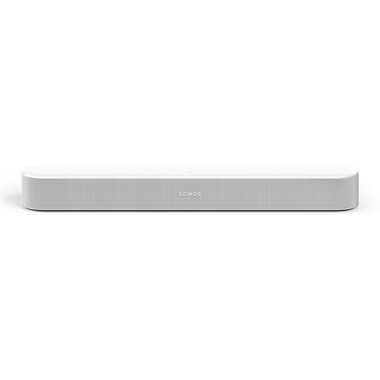 Sonos Beam Gen 2 Soundbar
Sonos Beam Gen 2 Soundbar

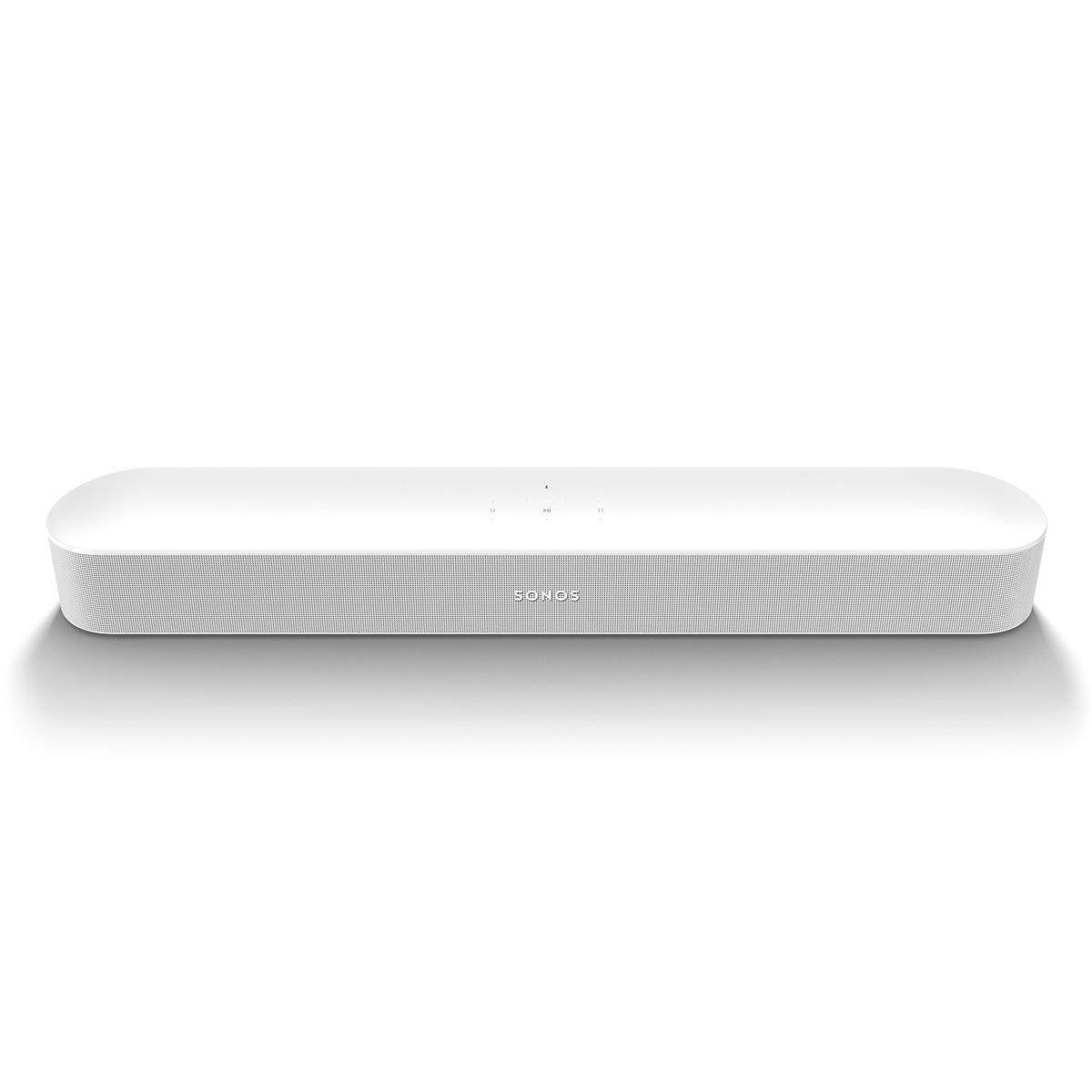

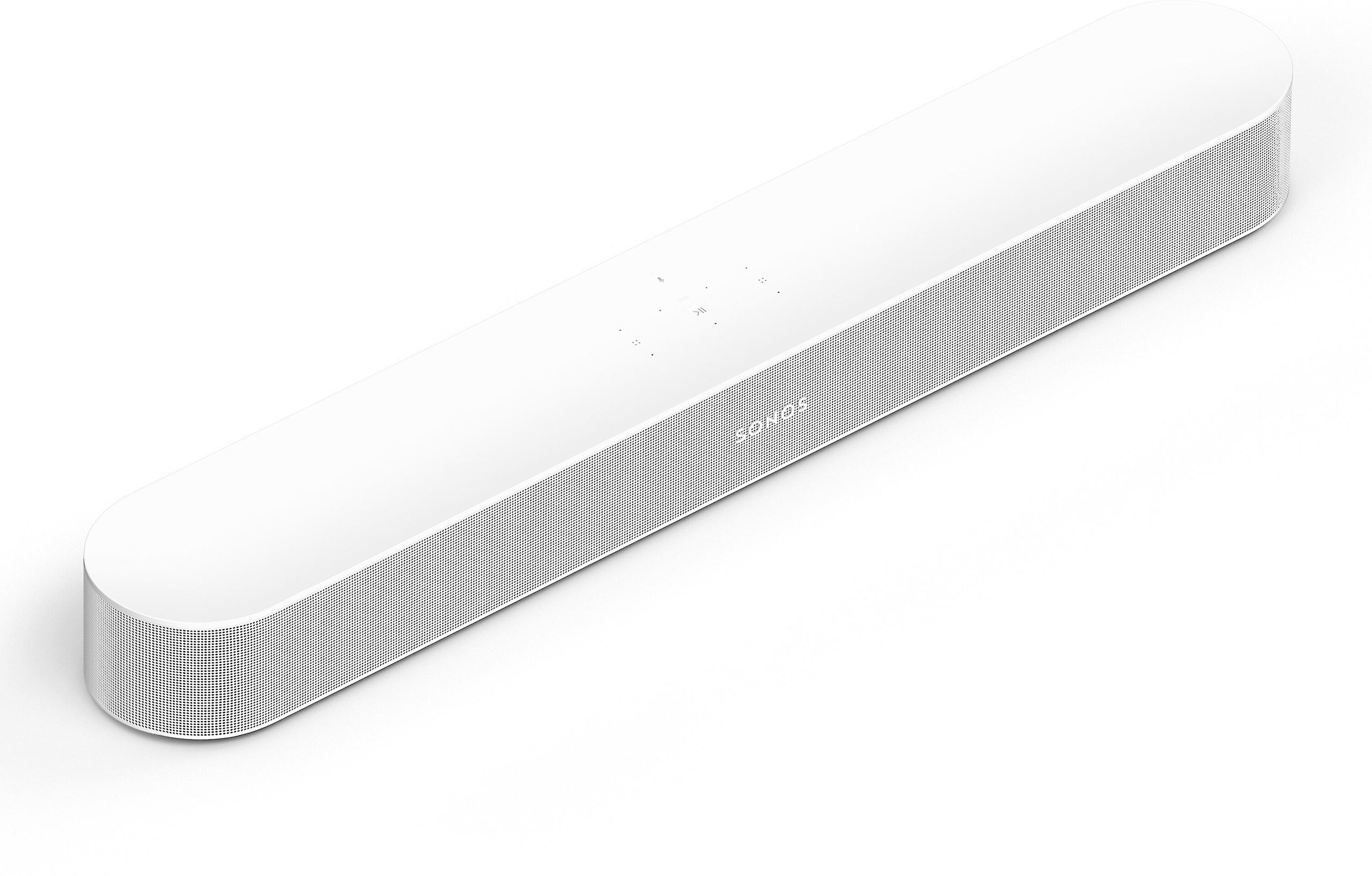




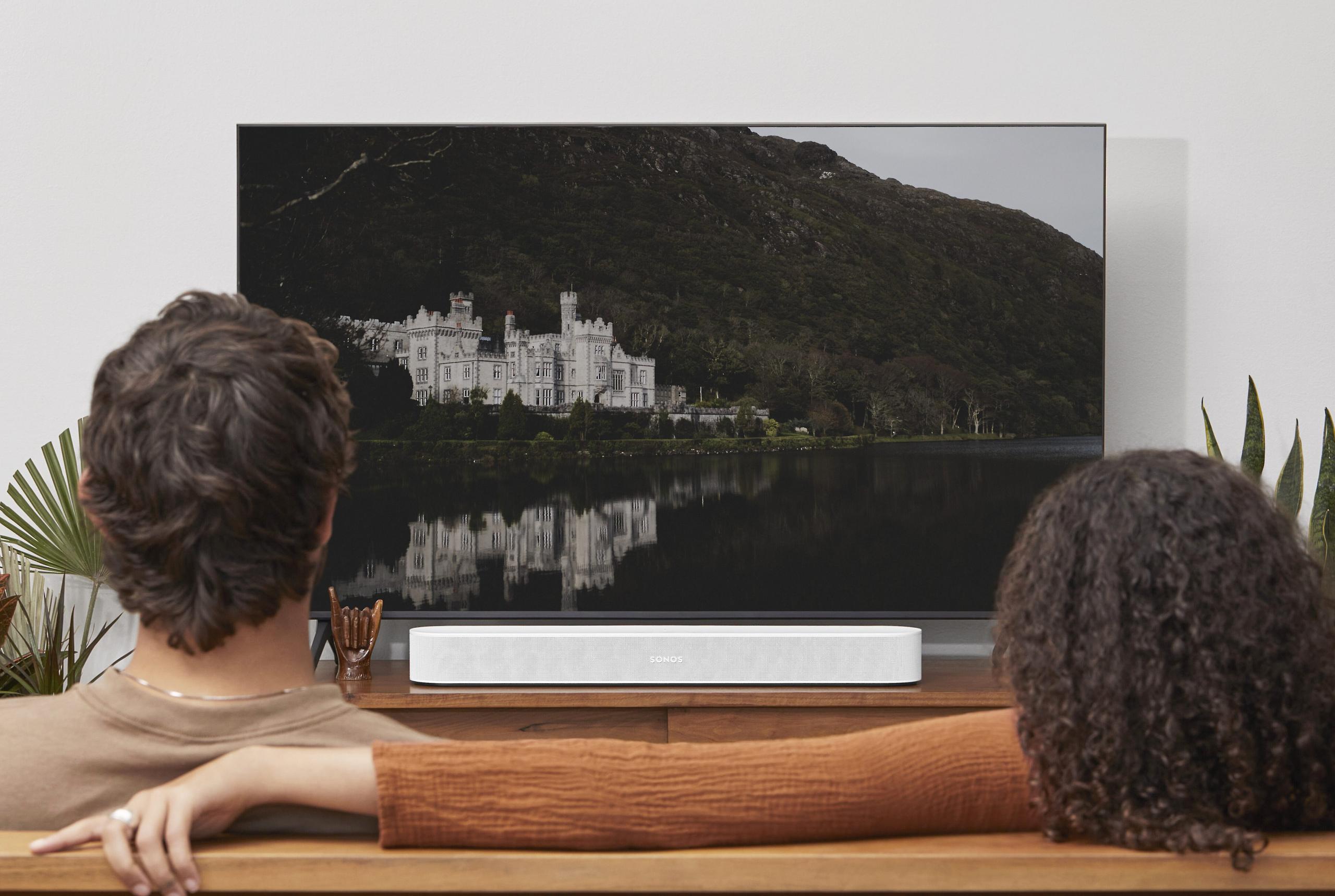
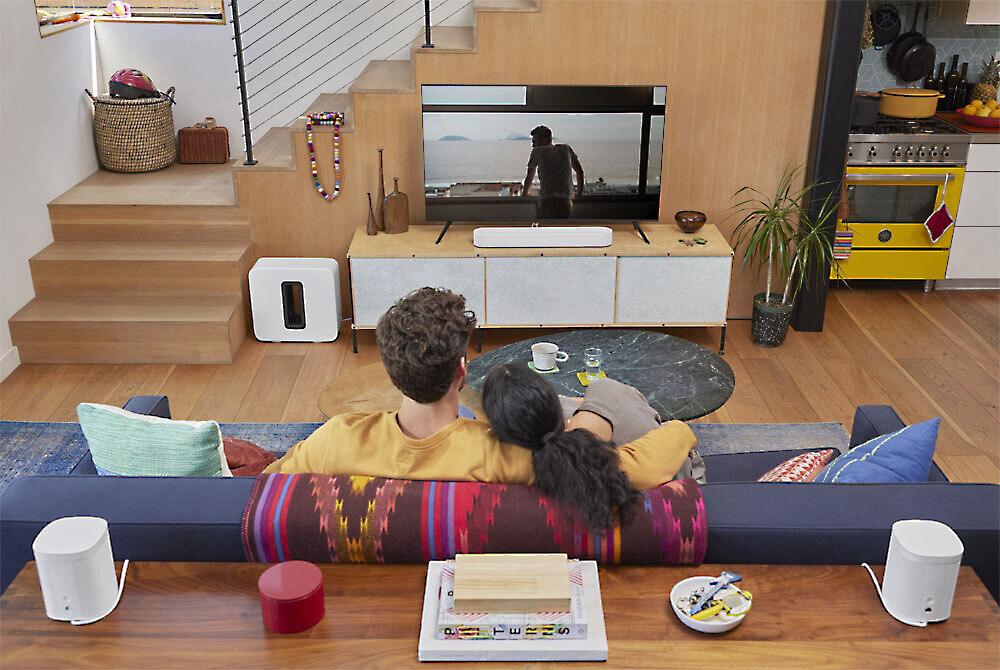
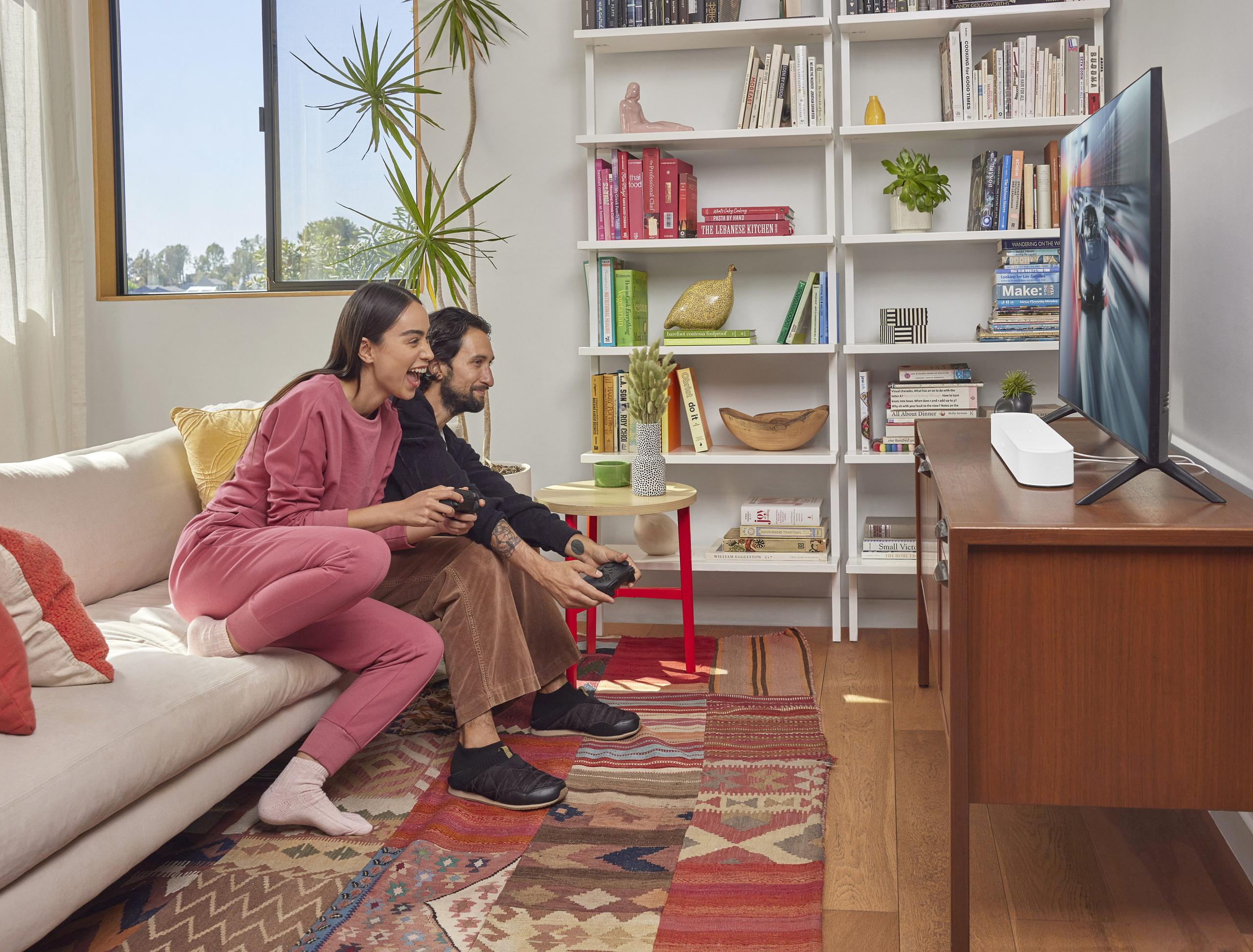
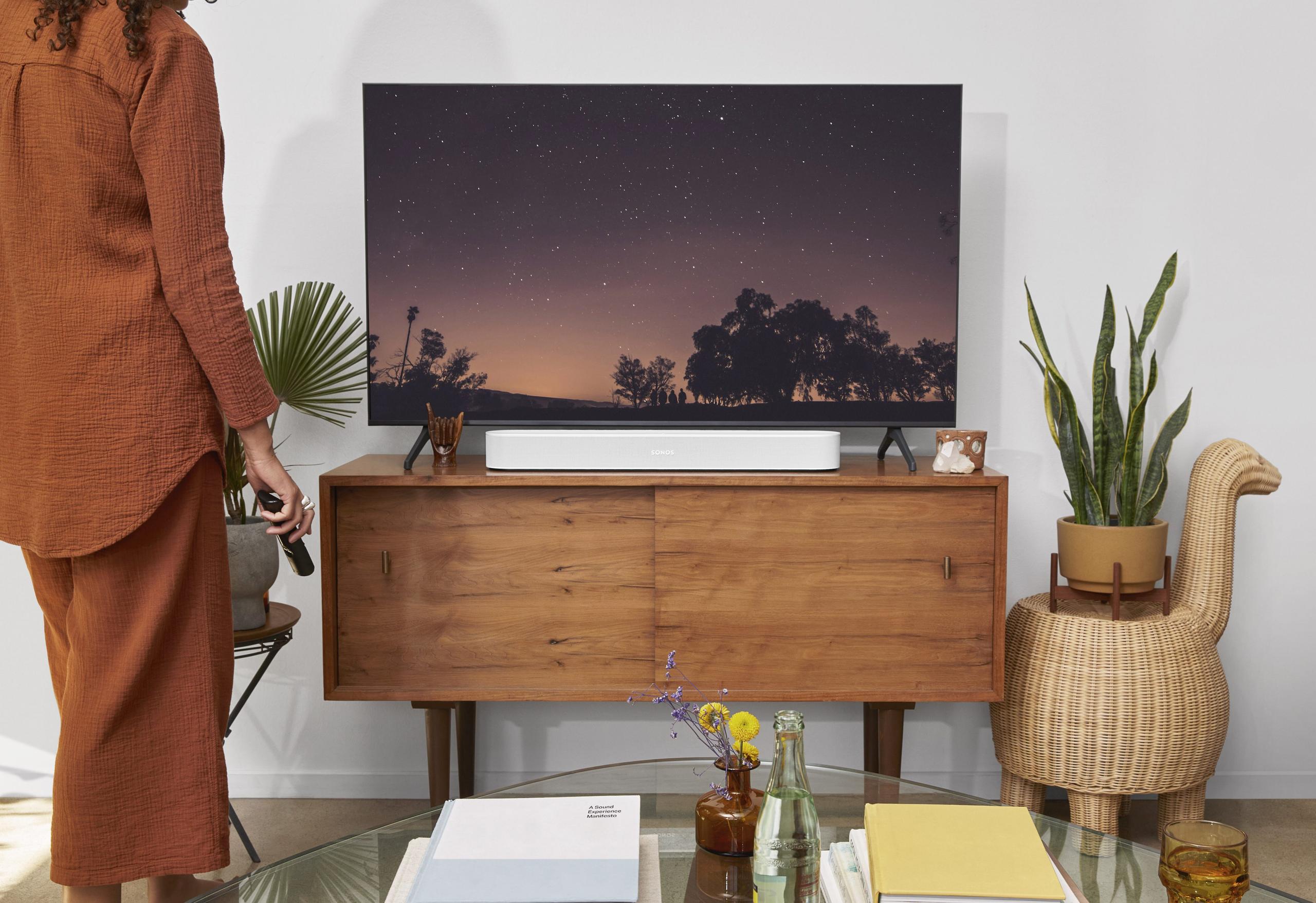
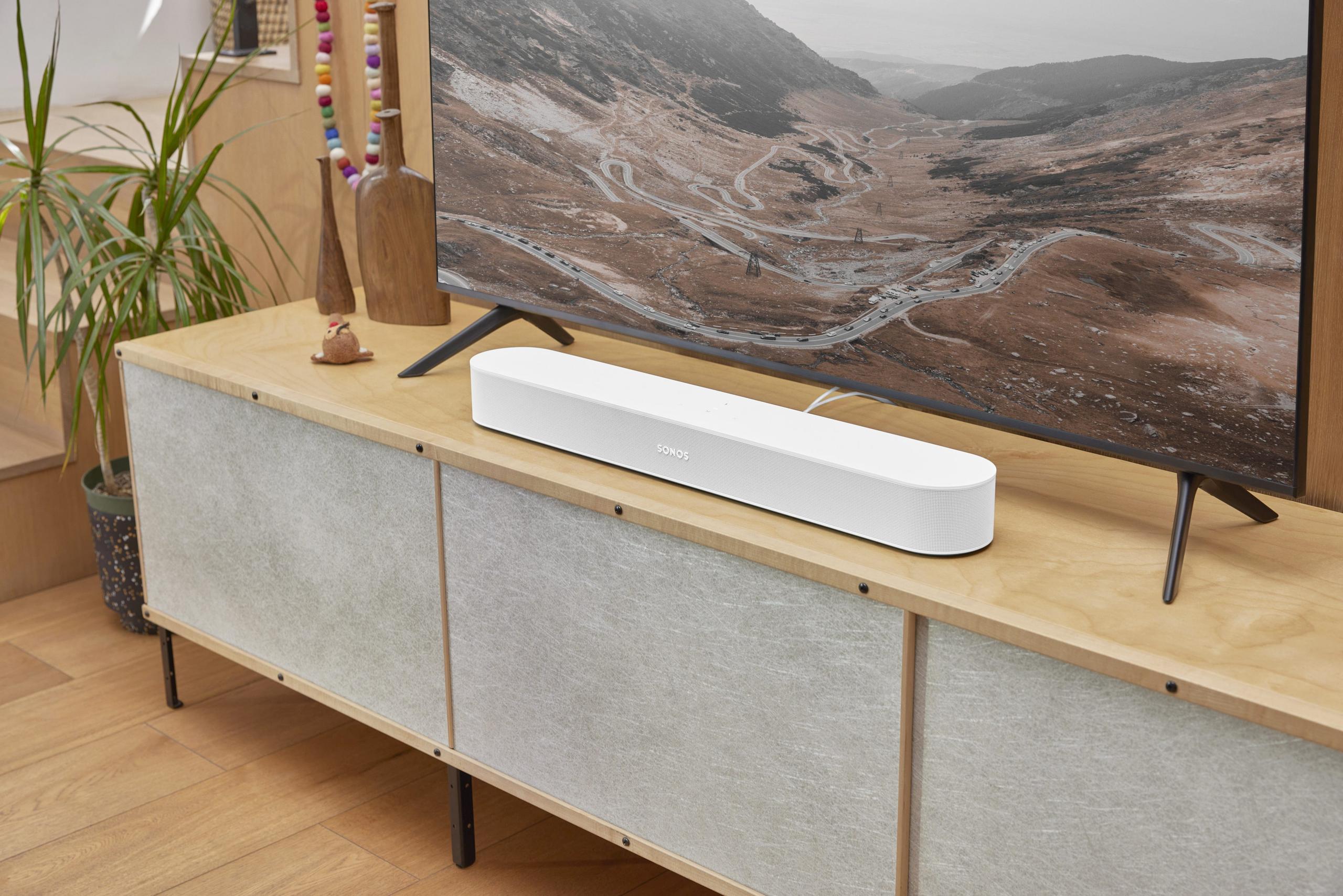













$499.00 Original price was: $499.00.$393.63Current price is: $393.63.
When Sonos released the Beam Gen 2 in late 2021, they aimed to pack more theater-like sound into the same compact design that made the original Beam so popular. After extensive testing across various room sizes and content types, we've found it delivers on that promise in impressive ways.
The soundbar market has changed dramatically since the original Beam's 2018 debut. Dolby Atmos, which creates immersive 3D sound by precisely placing audio in virtual space around you, has become a must-have feature. The Beam Gen 2 brings this technology to a compact form factor through clever digital processing rather than physical upward-firing speakers.
In our testing, the Beam Gen 2's audio performance punches well above its size class. The five-speaker array (four woofers and one tweeter) creates a surprisingly wide soundstage - that's the perceived width of the audio field. Movie dialogue comes through crystal clear thanks to the dedicated center channel processing, while action scenes have genuine impact without overwhelming the space.
The virtual Dolby Atmos implementation, while not quite matching systems with dedicated upward-firing speakers, creates a convincing sense of height and space. When testing with films like "Dune" and "Top Gun: Maverick," overhead effects were noticeably more precise than standard surround sound.
One of Sonos' secret weapons is TruePlay, their room calibration technology. Using an iOS device (sorry Android users), it measures how sound reflects off your walls and furniture, then adjusts the audio output to optimize for your specific space. We tested in both a small apartment living room and a larger open-concept space - the difference before and after calibration was significant in both cases.
The Beam Gen 2 shines as a smart home hub. Built-in Amazon Alexa and Google Assistant let you control not just your audio but your entire smart home setup. The HDMI eARC connection (an upgrade from the original's ARC) supports higher-quality audio formats and makes setup essentially plug-and-play with modern TVs.
The Sonos app remains one of the most intuitive ways to manage whole-home audio. You can stream from virtually any service, group speakers together, or play different content in different rooms. AirPlay 2 support means Apple users can stream directly from their devices without opening the Sonos app.
In day-to-day use, the Beam Gen 2 proves incredibly versatile. For typical TV viewing, the Speech Enhancement feature makes dialogue clearer without requiring constant volume adjustments. Night Sound mode automatically tames loud explosions and boosts quiet scenes - perfect for late-night viewing without disturbing others.
Music playback is equally impressive. The balanced sound signature works well across genres, from classical to hip-hop. While hardcore bass heads might want to add the Sonos Sub, the built-in bass response is surprisingly capable for most users.
One of the Beam Gen 2's strengths is its expandability. While it performs admirably alone, you can add:
We tested both with and without rear surrounds - while the basic setup is excellent, adding surrounds creates a notably more immersive experience for movies and gaming.
Since its release, Sonos has continued to refine the Beam Gen 2 through software updates. Recent improvements include:
At $499, the Beam Gen 2 sits in the premium compact soundbar segment. While not cheap, its combination of sound quality, smart features, and expandability make it a solid long-term investment. The regular software updates and Sonos' track record of long-term support add additional value.
The Beam Gen 2 is ideal for:
It might not be the best choice if you:
After months of testing across various content types and room configurations, the Sonos Beam Gen 2 continues to impress. It strikes an excellent balance between performance, features, and size, making it a versatile choice for modern homes.
While audiophiles might prefer larger systems with dedicated Atmos speakers, the Beam Gen 2's virtual implementation is convincing enough for most users. The smart features, regular updates, and expansion options make it a future-proof choice that can grow with your needs.
For anyone looking to significantly upgrade their TV audio without overwhelming their space, the Beam Gen 2 should be at the top of their list. Its combination of sound quality, smart features, and expandability make it one of the most well-rounded soundbars in its price range.
Yes, the Sonos Beam Gen 2 offers excellent value at $499. It delivers impressive virtual Dolby Atmos, clear dialogue, and smart features in a compact design. For small to medium rooms, it provides high-quality sound with the flexibility to expand into a full surround system later.
The Sonos Beam Gen 2 uses virtual Dolby Atmos through digital processing rather than physical upward-firing speakers. While not as precise as "real" Atmos, it creates convincing height effects that enhance the viewing experience, especially in smaller rooms.
Yes, the Sonos Beam Gen 2 can be paired with the Sonos Sub for enhanced bass performance. You can also add two Sonos One speakers as rear surrounds to create a full 5.1 system.
The Sonos Beam Gen 2 excels at movie playback, with features like Speech Enhancement for clear dialogue, Dolby Atmos support for immersive sound, and Night Sound mode for late-night viewing. It's particularly effective for dialogue-heavy content and action movies in small to medium-sized rooms.
The main differences are size and power - the Arc is larger, louder, and has dedicated upward-firing speakers for Dolby Atmos. The Beam Gen 2 is more compact and affordable while still offering virtual Atmos and excellent sound quality.
While the Sonos Beam Gen 2 works perfectly well with Android devices, the TruePlay room calibration feature requires an iOS device. This is a one-time setup process, so you can borrow an iOS device if needed.
The Sonos Beam Gen 2 requires Wi-Fi for initial setup and most features. However, it can play audio from your TV through the HDMI connection without Wi-Fi once set up.
Yes, the Sonos Beam Gen 2 works well for gaming, offering low latency through HDMI eARC and good spatial audio for identifying directional sounds. The virtual Atmos adds immersion to compatible games.
The Sonos Beam Gen 2 performs best in rooms up to 200 square feet. While it can fill larger spaces, you might want to consider the Sonos Arc for rooms larger than this.
Yes, the Sonos Beam Gen 2 can be wall-mounted using Sonos' custom wall mount (sold separately). Its compact size and clean design make it well-suited for wall mounting beneath a TV.
We've done our best to create useful and informative comparisons to help you decide what product to buy. Our research has used advanced automated methods to create this comparison and perfection is not possible - please contact us for corrections or questions. These are the sites we've researched in the creation of this article: whathifi.com - en.community.sonos.com - techradar.com - youtube.com - consumerreports.org - bestbuy.com - youtube.com - sonos.com - wave-electronics.com - en.community.sonos.com - epicsystems.tech - tomsguide.com - bestbuy.com
| Sonos Beam Gen 2 Soundbar |
|---|
| Audio Channels - Determines surround capability: 5.0 channels |
| Dolby Atmos Support - Creates virtual height effects for immersive sound: Yes (Virtual) |
| HDMI eARC - Enables highest quality audio from modern TVs: Yes |
| Voice Assistants - For hands-free control and smart home integration: Alexa and Google Assistant |
| Driver Configuration - Affects sound quality and clarity: 4 woofers, 1 tweeter, 3 passive radiators |
| Room Calibration - Optimizes sound for your space: TruePlay (iOS devices only) |
| Multi-room Audio - Enables whole-home audio systems: Yes, via Sonos ecosystem |
| Wireless Connectivity: Wi-Fi, AirPlay 2 |
| Width: 25.6 inches |
| Height: 2.7 inches |
| Depth: 3.9 inches |
| Weight: 6.35 pounds |
| Additional Audio Features: Speech Enhancement, Night Sound mode |
| Expandability - Allows system growth: Compatible with Sonos Sub and surrounds |
| Warranty: 1 year parts and labor |
The Sennheiser AMBEO Plus ($1,499.95) stands out with its significantly more powerful 7.1.4 virtual channel configuration and sophisticated room calibration system. Its larger size accommodates dual built-in subwoofers that deliver impressive bass without requiring additional speakers, while its advanced AMBEO virtualization technology creates a more convincing three-dimensional soundstage. The inclusion of multiple HDMI inputs, Bluetooth connectivity, and Chromecast support also makes it more versatile as a standalone unit compared to the Beam Gen 2's more limited connectivity options.
However, this enhanced performance comes at a significant price premium that's over four times the cost of the Beam Gen 2. While the AMBEO Plus undoubtedly delivers superior audio quality, particularly for movie watching and gaming, the value proposition becomes more complicated unless you have a larger room and specifically need its advanced features. The AMBEO Plus makes the most sense for dedicated home theater enthusiasts who want premium sound without the complexity of multiple speakers, whereas the Beam Gen 2 offers a more practical solution for typical living rooms and multi-purpose spaces.
🤖 Read Detailed Comparison
👌Sennheiser AMBEO Soundbar Plus Home Theater System Details
💵 See Sennheiser AMBEO Soundbar Plus Home Theater System Price
The Sonos Ray ($279) offers an attractive entry point into the Sonos ecosystem, particularly excelling in dialogue clarity and stereo performance in smaller rooms. Its compact design and focused audio projection make it an excellent choice for bedrooms or small living spaces where the Beam Gen 2's power might be excessive. The Ray's simplified connectivity with optical-only input actually works in its favor for basic setups, eliminating potential HDMI compatibility issues some users experience.
However, the Ray's limitations become apparent when comparing home theater capabilities. While it handles standard TV audio admirably, it lacks the Beam Gen 2's Dolby Atmos support, room-filling sound, and voice control features. The Ray remains a solid choice for those prioritizing clear dialogue and music playback in smaller spaces, but home theater enthusiasts will find the Beam Gen 2's additional features and superior audio processing worth the price premium. The Ray's value proposition makes the most sense for secondary TVs or situations where smart features and advanced audio formats aren't priorities.
🤖 Read Detailed Comparison
👌Sonos Ray Soundbar Details
💵 See Sonos Ray Soundbar Price
The $799 Polk MagniFi Max AX takes a fundamentally different approach with its complete home theater package, including a dedicated wireless subwoofer and physical up-firing speakers for Dolby Atmos effects. Where the Beam Gen 2 relies on digital processing, the Polk system delivers more impactful bass and a more convincing sense of height through traditional speaker design. This makes a noticeable difference in movie watching, particularly during action scenes where the dedicated subwoofer provides that visceral impact that's missing from the Beam's built-in bass drivers.
However, this enhanced performance comes with trade-offs in both cost and complexity. The Polk system requires more space for optimal placement of its components and sometimes needs manual tweaking to achieve the best sound balance. While it offers superior home theater performance out of the box, it lacks the refined app experience and regular feature updates that Sonos provides. For larger rooms and dedicated home theater setups, the Polk MagniFi Max AX provides excellent value with its included subwoofer and immersive sound capabilities, but apartment dwellers and those prioritizing simplicity might find the Beam Gen 2's compact, all-in-one approach more practical.
🤖 Read Detailed Comparison
👌Polk Audio MagniFi Max AX 3.1.2 Soundbar Details
💵 See Polk Audio MagniFi Max AX 3.1.2 Soundbar Price
The JBL Bar 300 offers compelling value at $100 less than the Beam Gen 2, particularly impressing with its built-in bass performance that eliminates the need for a separate subwoofer. Its MultiBeam technology creates a notably wide soundstage that works well in larger rooms, and the inclusion of direct Bluetooth connectivity provides simpler device pairing for casual listening. The Bar 300's built-in room calibration works with any smartphone, unlike Sonos' iOS-only TruePlay, and its straightforward setup process makes it more approachable for users who want great sound without diving into complex audio configurations.
However, the Bar 300 falls short of the Beam Gen 2 in several key areas. While it supports Dolby Atmos, the implementation isn't as refined, and dialogue clarity, while good, doesn't match the Beam's precision. The JBL Bar 300 also lacks expandability options - you can't add surrounds or a subwoofer later - and its standard ARC connection limits some advanced audio formats. These tradeoffs make it a better fit for users who prioritize immediate performance over future upgradability and those who want stronger bass response without the additional cost of a subwoofer.
🤖 Read Detailed Comparison
👌JBL Bar 300 5.0 Soundbar Details
💵 See JBL Bar 300 5.0 Soundbar Price
The Yamaha SR-B30A takes a different approach with its all-in-one design, featuring dual built-in subwoofers that deliver immediate, satisfying bass without requiring additional purchases. At $279, it offers compelling value for those wanting a complete solution out of the box. The integrated bass performance is particularly impressive for its price point, and Yamaha's Clear Voice technology provides good dialogue clarity across movies and TV shows. The wider soundbar design allows for better stereo separation, though it requires more TV stand space.
Where the Yamaha differs most significantly is in its standalone nature - there's no option to expand the system later with additional speakers or subwoofers. The Yamaha SR-B30A also takes a simpler approach to connectivity, offering basic Bluetooth streaming without the smart features or multi-room capabilities of the Sonos ecosystem. This focused approach results in a straightforward setup process and solid performance for most TV and movie watching scenarios, making it an excellent choice for those who want good sound without the complexity or cost of a modular system.
🤖 Read Detailed Comparison
👌Yamaha SR-B30A Sound Bar with Built-In Subwoofers Details
💵 See Yamaha SR-B30A Sound Bar with Built-In Subwoofers Price
The Bose TV Speaker takes a fundamentally different approach at a much lower $199 price point, focusing on simplicity and core sound performance rather than advanced features. Its standout characteristic is excellent dialogue clarity through its dedicated speech enhancement mode, and while it can't match the Beam Gen 2's expansive soundstage or Atmos capabilities, it delivers surprisingly good stereo sound that's noticeably better than TV speakers. The straightforward setup process and basic remote control make it an appealing option for users who want better TV audio without dealing with apps or network connectivity.
For pure value comparison, the Bose TV Speaker represents a solid choice if you're primarily concerned with improving TV dialogue and basic stereo performance. However, you'll miss out on key features like multi-room audio, voice control, and the ability to expand to a full surround system later. The sound quality difference is noticeable - while the Bose handles dialogue well, it can't match the Beam Gen 2's room-filling sound, deeper bass response, or ability to create an immersive listening experience with movies and TV shows. For basic TV audio enhancement in smaller rooms or for viewers who prioritize simplicity, the Bose offers good value, but home theater enthusiasts will find the investment in the Beam Gen 2's additional capabilities worthwhile.
🤖 Read Detailed Comparison
👌Bose TV Speaker Soundbar Details
💵 See Bose TV Speaker Soundbar Price
The JBL Bar 700 ($899) represents a more traditional home theater approach, delivering immediate surround sound satisfaction with its complete 5.1 system. The inclusion of detachable wireless rear speakers and a powerful 10-inch subwoofer creates a genuinely immersive listening experience that virtual processing simply can't match. Its PureVoice dialogue enhancement technology and automatic room calibration make it particularly effective for movie watching, while the physical speaker separation provides precise audio placement for both films and gaming. The system's 620W total power output and dedicated center channel ensure that every sound effect and spoken word comes through clearly, even in larger rooms.
While the JBL system commands a higher price point than the Beam Gen 2, it delivers superior home theater performance out of the box without requiring additional purchases. The Bar 700's detachable rear speakers offer unique flexibility for occasional surround sound setup, and the wireless subwoofer adds impactful bass that transforms the movie-watching experience. However, buyers should consider that this system requires more space and setup complexity than the Beam Gen 2, and its expansion options are more limited. For those prioritizing immediate home theater impact over gradual system building, the JBL Bar 700's complete package and superior surround sound performance justify its premium positioning.
🤖 Read Detailed Comparison
👌JBL Bar 700 Dolby Atmos 5.1 Soundbar with Subwoofer Details
💵 See JBL Bar 700 Dolby Atmos 5.1 Soundbar with Subwoofer Price
The $1,099 Sony BRAVIA Theater Bar 9 takes a significantly different approach with its premium positioning and larger physical presence. Its standout feature is the 13-speaker array system that creates a more expansive soundstage, particularly noticeable in larger rooms over 300 square feet. When paired with a Sony TV, the Acoustic Center Sync feature delivers notably better dialogue positioning and overall integration. The BRAVIA Bar 9's native bass response is also more robust, though like the Beam Gen 2, it still benefits from adding a separate subwoofer for true home theater performance.
While the BRAVIA Bar 9 offers superior raw performance and more convincing Dolby Atmos implementation through its dedicated height channels, its price point more than doubles that of the Beam Gen 2. For those with larger spaces and dedicated home theater setups, the $1,099 BRAVIA Bar 9 justifies its premium with better sound separation, more powerful output, and advanced features like HDMI 2.1 with 4K/120Hz passthrough. However, its 51-inch width requires significant space, and many of its advanced features are most valuable when paired with a Sony TV, making it a more specialized choice compared to the Beam Gen 2's versatility.
🤖 Read Detailed Comparison
👌Sony BRAVIA Theater Bar 9 Soundbar Details
💵 See Sony BRAVIA Theater Bar 9 Soundbar Price
The Klipsch Flexus Core 200 takes a different approach to home theater audio, offering true Dolby Atmos through dedicated upfiring speakers and built-in dual subwoofers. At 44 inches wide, it's significantly larger than the Beam Gen 2 but delivers more impactful movie performance without requiring additional purchases. The inclusion of physical height channels and integrated bass makes it particularly compelling for dedicated home theater use, though it lacks the smart features and streaming capabilities that Sonos users enjoy.
While priced higher at $499, the Klipsch Flexus Core 200 provides better value for those primarily focused on movie and TV performance, especially considering you'd need to spend significantly more on the Beam Gen 2 to match its bass capabilities. However, the tradeoff comes in the form of simpler connectivity (just Bluetooth and HDMI) and a larger footprint that might not suit smaller spaces. The Klipsch's more traditional approach to audio, with its focus on physical speakers rather than digital processing, delivers a more convincing home theater experience but without the ecosystem benefits and whole-home audio capabilities that make the Beam Gen 2 so versatile.
🤖 Read Detailed Comparison
👌Klipsch Flexus Core 200 3.1.2 Soundbar Details
💵 See Klipsch Flexus Core 200 3.1.2 Soundbar Price
The Klipsch Flexus Core 100 ($349) takes a different approach with its built-in dual 4-inch subwoofers, delivering impressive bass response without requiring additional purchases. While it can't match the Beam Gen 2's Dolby Atmos performance, it excels at traditional stereo playback and offers a more complete out-of-box solution for those who prioritize immediate sound quality over smart features. The premium materials, including wood construction and metal accents, give it a more upscale appearance that many users prefer over plastic soundbar designs.
For pure audio performance, the Klipsch Flexus Core 100 holds its own, particularly with music and standard TV content where its traditional hi-fi approach shines through. However, it lacks the versatility of Sonos's ecosystem, offering only basic Bluetooth connectivity instead of Wi-Fi streaming, multi-room capabilities, or voice control. This makes it a better choice for users who want straightforward, high-quality audio without the complexity of smart features, though they'll miss out on the expandability and regular software updates that Sonos provides.
🤖 Read Detailed Comparison
👌Klipsch Flexus Core 100 Soundbar Details
💵 See Klipsch Flexus Core 100 Soundbar Price
The $1,139.95 JBL Bar 1000 takes a dramatically different approach with its full surround sound system, including a powerful 10-inch wireless subwoofer and innovative detachable rear speakers. While significantly more expensive, it delivers a true home theater experience with physical up-firing speakers for Dolby Atmos, precise sound positioning through its 7.1.4 channel configuration, and room-filling 880W of total power. The detachable rear speakers are particularly clever, charging when attached to the main soundbar and providing flexible placement options for optimal surround sound.
For those with larger rooms or dedicated home theater spaces, the JBL Bar 1000's superior bass response and genuine surround sound capabilities make it worth the premium price. The physical speaker separation creates a more immersive experience that virtual processing can't match, while the dedicated subwoofer provides impactful low frequencies that transform action movies and gaming sessions. However, this enhanced performance comes with additional complexity in setup and requires more space to achieve optimal results. The JBL Bar 1000 represents a significant step up in both price and performance, making it better suited for serious home theater enthusiasts rather than those seeking a simple TV audio upgrade.
🤖 Read Detailed Comparison
👌JBL Bar 1000 Surround Sound System with 7.1.4 Channel Soundbar, 10" Wireless Subwoofer, Detachable Rear Speakers, and Dolby Atmo Details
💵 See JBL Bar 1000 Surround Sound System with 7.1.4 Channel Soundbar, 10" Wireless Subwoofer, Detachable Rear Speakers, and Dolby Atmo Price
The Yamaha SR-B40A ($399.95) stands out with its dedicated wireless subwoofer, which delivers noticeably deeper and more impactful bass compared to the Beam Gen 2's internal drivers. This difference is particularly evident during movie explosions, action sequences, and bass-heavy music. The SR-B40A also provides full Dolby Atmos support and higher total power output at 200W, making it more suitable for larger rooms and home theater applications. Its straightforward plug-and-play setup and auto-pairing subwoofer make installation hassle-free, though it lacks the smart features and voice control capabilities of the Sonos.
While the SR-B40A costs slightly more, it offers excellent value for those primarily focused on home theater performance and who don't need multi-room audio capabilities. The included subwoofer eliminates the need for future bass upgrades, and its dedicated sound modes for movies and gaming enhance content-specific performance. However, buyers should consider that the Yamaha SR-B40A can't be expanded with additional speakers and lacks the streaming versatility of the Sonos ecosystem. For pure audio performance and immediate impact in movies and games, it's a compelling alternative to the Beam Gen 2, especially for larger spaces where bass presence matters more.
🤖 Read Detailed Comparison
👌Yamaha SR-B40A 2.1-Channel Sound Bar with Wireless Subwoofer Details
💵 See Yamaha SR-B40A 2.1-Channel Sound Bar with Wireless Subwoofer Price
The $999.99 LG S95TR takes a dramatically different approach with its full 9.1.5 channel system, including dedicated rear speakers, up-firing height channels, and a powerful wireless subwoofer. Where the Beam Gen 2 relies on virtual processing, the S95TR delivers true surround sound with physical speakers positioned around your room. This results in notably more precise audio placement and significantly more impactful bass, especially during intense movie scenes or gaming sessions. The addition of multiple HDMI inputs and 4K/120Hz passthrough also makes it more versatile for complex home theater setups.
However, this superior performance comes with considerable trade-offs in terms of price, complexity, and space requirements. The S95TR costs nearly three times as much and needs careful speaker placement to achieve optimal results. For larger rooms and dedicated home theater spaces where immersive sound is a priority, these compromises may be worthwhile. But for many users, especially those in apartments or smaller rooms, the extra investment and setup complexity might not justify the performance gains over the Beam Gen 2's more elegant single-bar solution.
🤖 Read Detailed Comparison
👌LG S95TR 9.1.5 Channel Soundbar with Dolby Atmos Soundbar Details
💵 See LG S95TR 9.1.5 Channel Soundbar with Dolby Atmos Soundbar Price
The Bose Solo Series 2 ($179) takes a simpler approach to TV audio enhancement, focusing on core sound improvement without the complexity of smart features. Its straightforward plug-and-play setup using optical audio and basic Bluetooth connectivity appeals to users who want hassle-free installation. The dedicated dialogue enhancement mode works effectively for improving speech clarity in movies and TV shows, while its compact design fits well in smaller rooms or secondary viewing spaces.
However, the Bose Solo Series 2 lacks many modern features that have become standard in its price range. The absence of HDMI connectivity, Dolby Atmos support, and multi-room capabilities make it feel dated compared to the Beam Gen 2. While it provides a noticeable upgrade over built-in TV speakers, its basic 2.0 channel configuration and limited expandability options mean you won't get the same immersive soundstage or future upgrade path. For those prioritizing simplicity and budget over advanced features, it remains a viable option, but most users would benefit from investing in the more capable Beam Gen 2 if their budget allows.
🤖 Read Detailed Comparison
👌Bose Solo Soundbar Series 2 Soundbar Details
💵 See Bose Solo Soundbar Series 2 Soundbar Price
The Samsung HW-B550D ($177.99) takes a different approach to home theater sound, offering a dedicated wireless subwoofer and 3.1 channel configuration at about half the price of the Beam Gen 2. Its standout feature is the physical subwoofer, which delivers noticeably more powerful bass impact for movies and games. While it doesn't support Dolby Atmos, the included DTS Virtual:X processing creates a convincing surround effect, and the dedicated center channel ensures clear dialogue delivery. The gaming mode and bass boost features provide useful customization options for different content types.
Where the Samsung system really shines is in pure home theater performance per dollar. Though it lacks the Sonos's smart features and multi-room capabilities, the Samsung HW-B550D focuses on delivering impactful movie and TV audio with minimal complexity. The included subwoofer and higher total power output make it particularly well-suited to larger rooms where the Beam Gen 2 might struggle to fill the space. For viewers primarily interested in enhancing their TV audio without investing in a premium smart speaker system, the Samsung offers excellent value while still providing key features like HDMI-ARC connectivity and Bluetooth streaming.
🤖 Read Detailed Comparison
👌Samsung HW-B550D 3.1 Channel Sound Bar Details
💵 See Samsung HW-B550D 3.1 Channel Sound Bar Price
The $277.99 Samsung B-Series 5.1 takes a different approach by including a wireless subwoofer in the base package, immediately delivering fuller bass response and true surround sound capabilities. Its traditional 5.1 channel setup, complete with built-in side speakers and DTS Virtual:X technology, provides excellent sound separation and room-filling audio without requiring additional purchases. The included subwoofer makes a noticeable difference in both movies and gaming, offering impactful low-end performance that the Beam Gen 2 can't match without its optional $749 subwoofer.
Where the Samsung B-Series really shines is in larger rooms and dedicated home theater setups, offering better value for those who want immediate full-range sound without building a system over time. While it lacks Dolby Atmos support and the sophisticated smart features of the Sonos ecosystem, it compensates with additional connectivity options including optical and USB inputs, plus a dedicated game mode that optimizes audio for gaming sessions. However, you'll miss out on the multi-room audio capabilities and regular software updates that Sonos provides, making this a better choice for users focused primarily on TV and movie performance rather than smart home integration or whole-house audio.
🤖 Read Detailed Comparison
👌Samsung B-Series 5.1 Channel Soundbar with Subwoofer Details
💵 See Samsung B-Series 5.1 Channel Soundbar with Subwoofer Price
The Sony HT-A8000 ($698.00) takes a different approach to home theater audio with its larger footprint and more powerful hardware. Where it really stands out is in its physical speaker array - with 11 drivers including dedicated up-firing units for Dolby Atmos, it delivers more convincing overhead effects and a wider soundstage. The inclusion of HDMI 2.1 features makes it more future-proof for gaming, while its dedicated center channel provides notably better dialogue clarity in complex action scenes.
However, at nearly double the price of the Beam Gen 2, the HT-A8000's advantages need to justify that premium for your specific situation. While it offers superior pure audio performance and works exceptionally well with Sony Bravia TVs, it lacks Sonos's refined multi-room capabilities and streaming features. The HT-A8000 makes more sense for larger rooms, dedicated home theater setups, or when paired with a Sony TV where its integration features can be fully utilized. For many users, especially those in smaller spaces or who prioritize music streaming, the Beam Gen 2's more compact form factor and extensive streaming capabilities might represent better value.
🤖 Read Detailed Comparison
👌Sony HT-A8000 BRAVIA Theater Bar 8 Soundbar Details
💵 See Sony HT-A8000 BRAVIA Theater Bar 8 Soundbar Price
The Samsung HW-Q800D takes a different approach to home theater sound, offering a more traditional 5.1.2 setup with dedicated up-firing speakers and a separate wireless subwoofer. This configuration delivers noticeably more impactful bass and more convincing Dolby Atmos effects, particularly beneficial in medium to large rooms where the physical speakers can create a more immersive soundstage. The inclusion of SpaceFit Sound Pro room correction and Q-Symphony integration with Samsung TVs adds value for those already in the Samsung ecosystem, though these features aren't as versatile as Sonos's platform-agnostic approach.
At $699, the Samsung HW-Q800D commands a $200 premium over the Beam Gen 2, but justifies this with its additional hardware and superior home theater performance. However, it requires more space for the separate subwoofer and doesn't offer the same multi-room expansion possibilities. While it excels in movie performance and gaming scenarios where deep bass and overhead effects matter, it may be overkill for smaller rooms or for users who prioritize music streaming and smart features over maximum home theater impact.
🤖 Read Detailed Comparison
👌Samsung HW-Q800D 5.1.2 Channel Soundbar Details
💵 See Samsung HW-Q800D 5.1.2 Channel Soundbar Price
The Sonos Arc Ultra ($999) takes everything up several notches with its larger 46-inch design housing 14 precisely-engineered drivers, including dedicated up-firing speakers for true Dolby Atmos performance. This premium soundbar creates a notably wider soundstage and delivers more convincing height effects, particularly noticeable during movies with overhead sound effects like aircraft or rainfall. The built-in motion woofer also provides substantially better bass response without requiring a separate subwoofer, though serious home theater enthusiasts may still want to add one for maximum impact.
While the Arc Ultra's superior technical capabilities are impressive, the significant price difference raises important value considerations. For larger rooms over 300 square feet or dedicated home theater spaces, the Arc Ultra's enhanced performance and more immersive sound field justify its premium price tag. However, in smaller to medium-sized rooms, the extra power and speaker array may be overkill, and users might not fully benefit from its advanced capabilities. The Sonos Arc Ultra is best suited for those with both the space to appreciate its wider soundstage and the budget to invest in a premium audio solution.
🤖 Read Detailed Comparison
👌Sonos Arc Ultra Dolby Atmos Soundbar Details
💵 See Sonos Arc Ultra Dolby Atmos Soundbar Price
The LG S90TR takes a fundamentally different approach to home theater sound with its complete 7.1.3 channel system, including a powerful wireless subwoofer and dedicated rear speakers. While it commands a higher price at $800, it delivers a notably more immersive experience through physical upward-firing Atmos speakers and true surround sound capabilities. The dedicated subwoofer provides the kind of impactful bass you can feel during movies and games, something the Beam Gen 2 simply cannot match due to its compact single-unit design. For larger rooms and dedicated home theater spaces, the LG's superior power handling and wider soundstage create a more cinema-like experience.
Where the LG S90TR really shines is in action-heavy content and gaming, with its rear speakers creating precise directional audio and the subwoofer adding weight to explosions and sound effects. While it requires more space and setup consideration than the Beam Gen 2, the payoff is a more complete home theater experience out of the box. Features like AI room calibration and WOW Orchestra (when paired with LG TVs) add extra value, though they don't quite match the refinement of Sonos's room correction and multi-room capabilities. For those seeking maximum impact and true surround sound without stepping up to separate AV components, the LG offers compelling value despite its higher price point.
🤖 Read Detailed Comparison
👌LG S90TR 7.1.3 Channel Soundbar with Wireless Subwoofer and Rear Speakers - Soundbar Details
💵 See LG S90TR 7.1.3 Channel Soundbar with Wireless Subwoofer and Rear Speakers - Soundbar Price
The $1,997.99 Samsung HW-Q990D takes a drastically different approach to home theater audio, offering a complete surround sound solution with 22 drivers spread across a main soundbar, wireless subwoofer, and two rear speakers. Where the Beam Gen 2 relies on virtual processing for immersion, the HW-Q990D delivers true Dolby Atmos through dedicated up-firing speakers, creating genuine overhead effects that virtual processing can't match. Its 11.1.4 channel configuration and powerful subwoofer provide cinema-quality sound that's particularly noticeable during action scenes and gaming sessions, while features like SpaceFit Sound calibration and HDMI 2.1 support with VRR make it future-proof for modern entertainment setups.
While the HW-Q990D offers superior audio performance and a more immersive experience, it requires both significant space and budget considerations. The system needs room for proper speaker placement and comes at nearly six times the cost of the Beam Gen 2. For larger rooms and dedicated home theater spaces, the investment delivers tangible benefits in sound quality and immersion. However, in smaller spaces or for primarily casual viewing, the additional cost and complexity might not justify the performance gains. The HW-Q990D excels for those seeking premium home theater performance and have the space and budget to accommodate it, while the Beam Gen 2 remains a more practical choice for everyday environments and multi-room audio applications.
🤖 Read Detailed Comparison
👌Samsung HW-Q990D 11.1.4 Channel Sound Bar Details
💵 See Samsung HW-Q990D 11.1.4 Channel Sound Bar Price
The Samsung HW-S700D ($397) takes a different approach to room-filling sound with its 3.1 channel configuration and included wireless subwoofer. Its standout features include a dedicated center channel speaker that delivers exceptional dialogue clarity and the clever Q-Symphony technology that lets compatible Samsung TVs' speakers work in harmony with the soundbar instead of being disabled. The ultra-slim design at just 2.1 inches tall makes it particularly suitable for wall-mounting, while SpaceFit Sound automatically calibrates audio output based on your room's acoustics when paired with a Samsung TV.
Where the Samsung HW-S700D really shines is in larger rooms and with TV content, thanks to its more powerful output and included subwoofer providing deeper bass response out of the box. While it lacks Dolby Atmos support, the separate center channel and subwoofer combination often proves more beneficial for everyday viewing than virtual Atmos processing. It's also worth noting that the Samsung offers better initial value since you don't need to purchase a separate subwoofer, though it doesn't match the Beam Gen 2's multi-room flexibility or streaming capabilities.
🤖 Read Detailed Comparison
👌Samsung HW-S700D 3.1 Channel Slim Soundbar Details
💵 See Samsung HW-S700D 3.1 Channel Slim Soundbar Price
The Polk Audio Signa S4 represents a more traditional home theater approach, delivering impressive value at $269-349 with its true Dolby Atmos implementation and included wireless subwoofer. Where the Beam Gen 2 relies on virtual processing, the Signa S4 uses physical up-firing speakers to create genuine overhead effects, resulting in a more convincing three-dimensional soundstage. The included wireless subwoofer is a significant advantage, providing deep, impactful bass that you can feel during movies - something the Beam Gen 2 simply can't match without purchasing a separate subwoofer.
While the Polk Audio Signa S4 doesn't offer the same level of smart features or ecosystem integration, it excels in pure audio performance for its price point. Its Voice Adjust technology ensures clear dialogue without requiring complex room calibration, and the Bass Adjust feature lets users fine-tune low frequencies to their preference. For those primarily focused on movie and TV watching, especially in medium to large rooms, the Signa S4's more powerful output and true Atmos implementation offer better value than the Beam Gen 2's sophisticated but limited audio capabilities.
🤖 Read Detailed Comparison
👌Polk Audio Signa S4 Dolby Atmos Soundbar with Wireless Subwoofer Details
💵 See Polk Audio Signa S4 Dolby Atmos Soundbar with Wireless Subwoofer Price
The Sony HT-A5000 ($639) represents a more theater-focused approach with its true 5.1.2 channel configuration and dedicated up-firing speakers for Dolby Atmos effects. Its built-in subwoofer and powerful 450W output provide significantly more impact for movie soundtracks and gaming, eliminating the need for an immediate subwoofer purchase. The physical speaker arrangement, including dedicated height channels, delivers a more convincing three-dimensional soundstage compared to the Beam Gen 2's virtual processing. While it commands a higher price, the Sony includes features like HDMI 2.1 support and Bluetooth connectivity that the Beam Gen 2 lacks, making it more versatile for various entertainment sources.
For larger rooms and dedicated home theater setups, the Sony HT-A5000 offers more compelling performance out of the box. Its superior power handling and physical speaker configuration create a more immersive experience for movies and games, though it doesn't quite match the Beam Gen 2's refined music streaming capabilities. The additional $190 investment brings notable benefits for home theater enthusiasts, particularly in rooms over 300 square feet where the extra power becomes more noticeable. However, the tradeoff comes in the form of a larger physical footprint and a less sophisticated multi-room audio implementation compared to Sonos's ecosystem.
🤖 Read Detailed Comparison
👌Sony HT-A5000 5.1.2 Channel Home Theater Soundbar Details
💵 See Sony HT-A5000 5.1.2 Channel Home Theater Soundbar Price
The Sonos Arc ($564.44) represents Sonos' flagship soundbar technology, offering notably superior audio performance through its 11-driver array including dedicated upward-firing speakers for true Dolby Atmos effects. Its larger 45-inch width and more sophisticated speaker arrangement create a dramatically wider soundstage and more convincing surround sound experience, particularly noticeable in larger rooms. While it demands a significant price premium, the Arc delivers tangible benefits for home theater enthusiasts, including more impactful bass response, clearer dialogue separation, and more precise positioning of sound effects in space.
However, the Sonos Arc's advantages come with practical considerations beyond just price. Its larger size requires more space and is best paired with TVs 49 inches or larger for proper aesthetic and acoustic matching. The improved audio performance is most noticeable in medium to large rooms where its powerful driver array can properly create an immersive sound field. While the Arc offers the best possible Sonos soundbar experience, its higher price and larger footprint make it overkill for smaller rooms or more casual viewing environments where the Beam Gen 2's capabilities would suffice.
🤖 Read Detailed Comparison
👌Sonos Arc Wireless Sound Bar with Dolby Atmos, Apple AirPlay 2, and Built-in Voice Assistant (White) Details
💵 See Sonos Arc Wireless Sound Bar with Dolby Atmos, Apple AirPlay 2, and Built-in Voice Assistant (White) Price
The Bose Smart Ultra Soundbar represents a significant step up in home theater performance, though at $699.99, it commands a considerable premium over the Beam Gen 2. Its standout features include physical up-firing speakers for true Dolby Atmos effects and an innovative AI-powered dialogue enhancement system that noticeably outperforms traditional speech modes. The larger 41-inch width creates a more expansive soundstage, particularly beneficial for TVs over 50 inches, while its custom dipole transducers and PhaseGuide technology deliver more convincing spatial effects that really shine during action sequences and immersive content. The inclusion of Bluetooth connectivity also adds convenient device pairing options that Sonos notably lacks.
However, the Bose Smart Ultra's advantages come with some trade-offs beyond just price. While it offers superior home theater performance, its larger size demands more space, and its smart features are more limited, supporting only Alexa due to Google's restrictions. The Bose ecosystem also isn't as extensive or flexible as Sonos for multi-room audio. For dedicated home theater enthusiasts with larger rooms and TVs, these compromises might be worth it for the enhanced immersion and dialogue clarity. However, more casual users might find it harder to justify the significant price premium over the Beam Gen 2's already impressive performance.
🤖 Read Detailed Comparison
👌Bose Smart Ultra Soundbar with Dolby Atmos Details
💵 See Bose Smart Ultra Soundbar with Dolby Atmos Price
$5,997.99 Original price was: $5,997.99.$5,797.99Current price is: $5,797.99.
$209.99 Original price was: $209.99.$198.99Current price is: $198.99.
$99.99 Original price was: $99.99.$69.99Current price is: $69.99.
$79.98 Original price was: $79.98.$58.95Current price is: $58.95.

